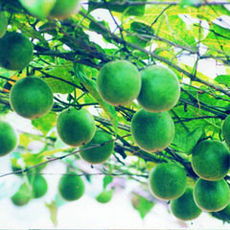| Model: | - |
|---|---|
| Brand: | - |
| Origin: | Made In China |
| Category: | Agriculture & Foods / Agricultural Products & Resources / Plant Extract |
| Label: | Luo han guo extract , Mogrosides , Mogroside Ⅴ |
| Price: |
-
|
| Min. Order: | - |
Product Description
1. Luo han guo extract
l Color: Fine yellow powder
l Latin name: Momordica grosvenori Swingle.
l Active ingredients: Mogrosides, Mogroside Ⅴ
l Specifications: 80% Mogrosides, 25% Mogroside Ⅴ, 30% Mogroside Ⅴ
l Solubility: Good soluble in water
l Plant used: 100% natural luo han guo fruit
l Packing:
l Annual availability: 80 MT of above mentioned specifications.
2. Brief description
Luo Han Guo (luohanguo) refers to the fruit of Siraitia grosvenori, formerly called Momordica grosvenori, a member of the Curcubitaceae. The fruit is well-known for its sweet taste; this plant family (Gourd family) has other members that contain remarkable sweet components, including additional species of the genus Siraitia (e.g., S. siamensis, S. silomaradjae, S. sikkimensis, S. africana, S. borneensis, and S. taiwaniana and the popular herb jiaogulan (Gynostemma pentaphyllum). The latter herb, which has both sweet and bitter tasting triterpene glycosides in its leaves, is now sold worldwide as a tea and made into an extract for use in numerous health-care products. Luohanguo has been used as a medicinal herb for treating cough and sore throat and is popularly considered, in southern
Luohanguo is primarily grown in southern
Luohanguo is collected as a round green fruit that turns brown upon drying. The sweet taste of luohanguo comes primarily from mogrosides, a group of terpene glycosides, present at the level of about 1% of the fleshy part of the fruit. Both the fresh and dried fruits are extracted to yield a powder that is 80% or more mogrosides. The mogrosides have been numbered, 1-5, and the main component is called mogroside-5, previously known as esgoside (see chemical structure diagram below). Other, similar compounds from luohanguo have been labeled siamenoside and neomogroside. The mixed mogrosides are estimated to be about 300 times as sweet as sugar by weight, so that the 80% extracts are nearly 250 times sweeter than sugar; pure mogrosides 4 and 5 may be 400 times as sweet as sugar by weight.
3. Applications of luo han guo:
1. Heat stroke with thirst: Take one fruit, break it open and stir into boiled water. Drink the liquid in place of tea.
2. Acute or chronic throat inflammation; aphonia. Take half a fruit and 3-5 seeds of sterculia. Cover with water and simmer, then swallow very slowly.
3. Chronic cough. Take 1 piece of fruit, cover with water, simmer, and drink the liquid. Do this twice each day.
4. Constipation in the aged. Take 2 pieces of fruit, obtain the juicy part and the seed (put the shell aside for other uses), break apart, cover with water, and simmer. Drink before going to bed.
5. Diabetes. Take an appropriate measure of the fruit and crush it or simmer it into a thick juice and add to food being prepared, using it as a substitute for sugar.
Member Information
| Changsha Natureway Co.,Ltd | |
|---|---|
| Country/Region: | Hu Nan - China |
| Business Nature: | Manufacturer |
| Phone: | +86 731 2866 768 |
| Contact: | Linda (Sales manager) |
| Last Online: | 15 Aug, 2009 |
Related Products of this Company
-
No Image
Tomato juice extract
-
Bilberry Extarct
-
No Image
Rhodiola rosea extract
-
No Image
Bitter melon extract 30:1
-
Barley grass juice powder





